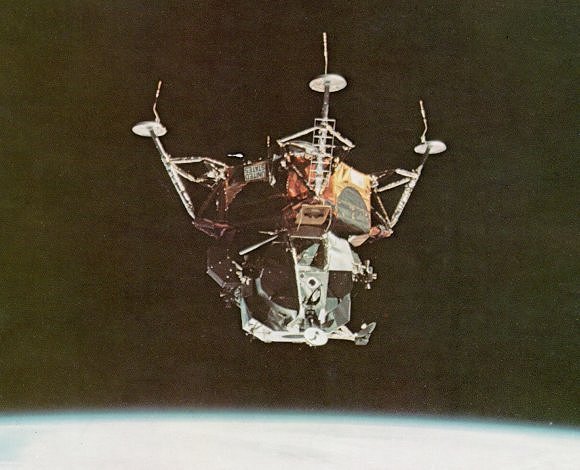Apollo Expeditions to the Moon
The Spaceships
By GEORGE M. LOW
| | |
Circling the Moon once every two hours in the CSM,
one lunar explorer awaits his colleagues
from the lunar surface. At the nose of the
craft is the extended docking probe, ready to receive
the LM. The bell-shaped rocket engine at the
rear must work one more time for return.
|
On April 3, 1967, NASA 2, a Grumman Gulfstream, was taxiing for takeoff
at Washington National Airport. Bob Gilruth, Director of NASA's Manned
Spacecraft Center and I (his Deputy at that time) were about to return to
Houston after a series of meetings in Washington. But just before starting
down the runway, the pilot received a cryptic message from the tower: return
to the terminal and ask the passengers to wait in the pilot's lounge.
Soon arrived Administrator Jim Webb, his Deputy Bob Seamans, George Mueller,
the head of Manned Space Flight, and Apollo Program Director Sam Phillips.
Counting Bob Gilruth, everybody in the NASA hierarchy between me and the
President was there.
| | |
Like a spider dancing upside down the lunar
module makes its first solo flight in Earth orbit.
The rods protruding from the footpods are to
give first indication of contact with the lunar
surface. The ladder on the front leg would
soon serve Neil Armstrong to take that "small
step for a man. . . ."
|
Jim Webb, using fewer words than usual, came right to the point: Apollo was
faltering; the catastrophic fire on January 27 that had taken the lives of
three astronauts had been a major setback. All its consequences were not yet known;
time was running out on the Nation's commitment to land on the Moon before the
end of the decade.
Then the punch line: NASA wanted me to take on the task of rebuilding the Apollo
spacecraft, and to see to it that we met the commitment.
Thus began the most exciting, most demanding, sometimes most frustrating, and
always most challenging 27 months in my career as an engineer. Not that Apollo was
completely new to me. Six years earlier I had chaired the NASA committee that recommended
a manned lunar landing and provided the background work for President
Kennedy's decision to go to the Moon. In the intervening years I had not been involved
in the day-to-day engineering details of the Apollo spaceships - yet 27 months later,
sitting at a console in the Launch Control Center during the final seconds of the countdown
for Apollo 11, I had come to know and understand two of the most complex
flying machines ever built by man.
|


